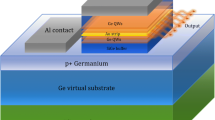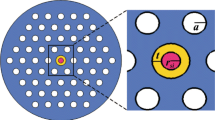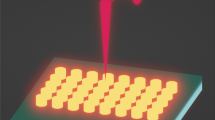Abstract
Recently, many researches are reported on using germanium in silicon-based lasers but acquiring this potential for a plasmonic nanolaser may also be important for development of silicon-compatible plasmon sources. In this paper, a custom-shaped nanocavity plasmon source based on highly doped tensile-strained germanium/silicon-germanium multiple quantum well gain medium is introduced and theoretically investigated. We have used a semi-classical macroscopic rate equation model for calculation of the output performance characteristics. Also, modal analysis has been done based on FDTD method. The proposed nanolaser has a tiny footprint of 0.1225 μm2, possible room temperature performance, and fabrication process based on a silicon substrate. The output performance of the nanolaser structure as estimated is noticeable and the calculated results, using some previously reported experimental data and redundant software double checking, show acceptable compatibility. In 1550-nm output wavelength, it provides 15.6 mW output power in the 21-mA threshold current and 600 μW in 1-mA pump current, while maintaining its performance in a wide spectral bandwidth about 2 THz. It also can be electrically modulated by the pump current up to 3 GHz. This remarkable performance is achieved, thanks to the high Purcell factor of the parabolically notched nanocavity of about 700 and its high quality factor of about 58.










Similar content being viewed by others
References
Enoch S, Bonod N (2012) Plasmonics. Springer, Heidelberg
Livani AM, Kaatuzian H (2015) Design and simulation of an electrically pumped Schottky–Junction–based plasmonic amplifier. Appl Opt 54(9):2164–2173
Moazzam MK, Kaatuzian H (2015) Design and investigation of a N-type metal/insulator/semiconductor/metal structure2port electro-plasmonic addressed routing switch. Appl Opt 54(20):6199–6207
Taheri AN, Kaatuzian H (2014) Design and simulation of a nanoscale electro-plasmonic 1 × 2 switch based on asymmetric metal–insulator–metal stub filters. Appl Opt 53(28):6546–6553
Rastegar Pashaki E, Kaatuzian H, Mallah Livani A, Ghodsi H (2018) Design and investigation of a balanced silicon-based plasmonic internal-photoemission detector. Appl Phys B Lasers Opt 125(1). https://doi.org/10.1007/s00340-018-7111-x
Stockman M (2010) The spaser as a nanoscale quantum generator and ultrafast amplifier. J Opt 12(2):024004
Liu K, Li N, Sadana D, Sorger V (2016) Integrated nanocavity plasmon light sources for on-Chip Optical interconnects. ACS Photonics 3(2):233–242
Ho J, Tatebayashi J, Sergent S, Fong C, Ota Y, Iwamoto S, Arakawa Y (2016) A nanowire-based plasmonic quantum dot laser. Nano Lett 16(4):2845–2850
Ding K, Ning C (2012) Metallic subwavelength-cavity semiconductor nanolasers. Light 1(7):e20–e20
Liu J, Sun X, Pan D, Wang X, Kimerling LC, Koch TL, Michel J (2007) Tensile-strained, n-type Ge as a gain medium for monolithic laser integration on Si. Opt Express 15:11272–11277
Camacho-Aguilera RE, Cai Y, Patel N, Bessette JT, Romagnoli M, Kimerling LC, Michel J (2012) An electrically pumped germanium laser. Opt Express 20:11316–11320
Cai Y et al (2013) Analysis of threshold current behavior for bulk and quantum-well germanium laser structures. IEEE J Sel Top Quantum Electron 19(4):1901009–1901009. https://doi.org/10.1109/jstqe.2013.2247573
Atwater H (2007) The promise of plasmonics. Sci Am 296(4):56–62
Chang G-E, Chen S-W, Cheng HH (2016) Tensile-strained Ge/SiGe quantum-well photodetectors on silicon substrates with extended infrared response. Opt Express 24:17562–17571
Nanophotonic FDTD (2019) Simulation software - lumerical FDTD solutions, Lumerical. [Online]. Available: http://www.lumerical.com/tcad-products/fdtd/. Accessed 5 Feb 2019
Nunes FD, Vasconcelos TC, Bezerra M, Weiner J (2011) Electromagnetic energy density in dispersive and dissipative media. J Opt Soc Am B 28:1544–1552
Purcell EM (1946) Spontaneous emission probabilities at radio frequencies. Phys Rev 69:681
Francs G et al (2016) Plasmonic Purcell factor and coupling efficiency to surface plasmons. Implications for addressing and controlling optical nanosources. J Opt 18(9):094005. https://doi.org/10.1088/2040-8978/18/9/094005
Ginzburg P (2016) Cavity quantum electrodynamics in application to plasmonics and metamaterials. Rev Phys 1:120–139
Yokoyama H, Nishi K, Anan T, Nambu Y, Brorson SD, Ippen EP, Suzuki M (1992) Controlling spontaneous emission and threshold-less laser oscillation with optical microcavities. Opt Quant Electron 24(2):S245–S272. https://doi.org/10.1007/bf00625827
Ma R, Oulton R, Sorger V, Zhang X (2012) Plasmon lasers: coherent light source at molecular scales. Laser Photonics Rev 7(1):1–21. https://doi.org/10.1002/lpor.201100040
Parfenyev V, Vergeles S (2014) Quantum theory of a spaser-based nanolaser. Opt Express 22(11):13671. https://doi.org/10.1364/oe.22.013671
Romero B, Arias J, Esquivias I, Cada M (2000) Simple model for calculating the ratio of the carrier capture and escape times in quantum-well lasers. Appl Phys Lett 76(12):1504–1506. https://doi.org/10.1063/1.126077
Taghavi I, Kaatuzian H, Leburton J (2013) Performance optimization of multiple quantum well transistor laser. IEEE J Quantum Electron 49(4):426–435. https://doi.org/10.1109/jqe.2013.2250488
Buck T, Brattain W (1955) Investigations of surface recombination velocities on germanium by the photoelectromagnetic method. J Electrochem Soc 102(11):636
Boriskina S et al (2017) Losses in plasmonics: from mitigating energy dissipation to embracing loss-enabled functionalities. Adv Opt Photon 9(4):775. https://doi.org/10.1364/aop.9.000775
Author information
Authors and Affiliations
Corresponding author
Additional information
Publisher’s Note
Springer Nature remains neutral with regard to jurisdictional claims in published maps and institutional affiliations.
Rights and permissions
About this article
Cite this article
Ghodsi, H., Kaatuzian, H. High Purcell Factor Achievement of Notched Cavity Germanium Multiple Quantum Well Plasmon Source. Plasmonics 15, 155–167 (2020). https://doi.org/10.1007/s11468-019-01012-w
Received:
Accepted:
Published:
Issue Date:
DOI: https://doi.org/10.1007/s11468-019-01012-w




